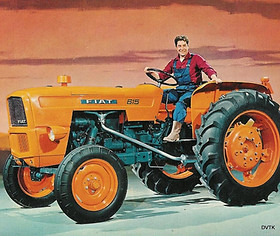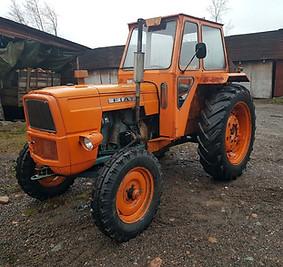top of page
FIAT 615








In the early 60's, Fiat launched an effort to streamline their lineup, with the intent of making their tractors easier to market and service, thereby strengthening their position internationally.
Fiat tractors had a reputation for being reliable, easy to maintain, and well priced. But not exactly for being or having a cohesive and original design language. For the replacement of the 100 series, Fiat therefor decided to hire the help of non other than Pinninfarina, the studio behind some of the most beautiful cars in history, and for many years Ferraris preferred designer and coachbuilder.
Introduced in 1965 the new, and officially Fiats first series, would be known as the "Diamond Series".
The 615 in the beginning, was the large size tractor of the series, later becoming the medium-to-large alternative, when the big 715 were introduced.
The 615 was a mild evolution of the Fiat 513R developed by OM, who was being fully integrated into the Fiat brand.
The tractor was sold domestically under the OM brand, and internationally as the Fiat 615.
Though in France, it would only be sold as the Someca 615. Someca being the agricultural arm of Fiats French subsidiary Simca.
The 615 was constructed using a heavy box section steel frame. In one end attached to each side of the gearbox and differential casing, in the middle carrying the OM developed engine, and the other end attached to the front axle.
The gearbox was a seven forward and two reverse, and had PTO and locking differential on the rear axle as standard, with the three-point hitch system being Fiats advanced "Control-Matic".
The 615's gearbox didn't come with synchronized gears like the 315 and 415. Instead the 615 offered the mechanically activated on-the-go reduction gear named "Amplicouple", later simply known as "Automatic", as an option for the 615 and later the larger 715.
With results similar to later and more advanced hydraulically and electrically activated powershift systems we know today, the Amplicouple/Automatic system would act as a quick engage and disengagement of the reduction gear in any gear, preventing the driver from having to come to a stop to engage the reduction gear, when momentum is most needed.
The reduction gear was "armed" by a leaver to the left of the driver. Power was sent through the PTO shaft, and could then be returned to the gearbox through the reduction gear on command via the clutch pedal. This reduction gear was only ment for emergencies though, as its engagement would wear out clutch and throwout bearings prematurely.
This coupled with the extra cost, ment that most costumers didn't order the Amplicouple reduction gear system.
Another advanced feature of this tractor, was the use of disc brakes. A very advanced technology for the time, rarely seen on other than high-performance cars of the time.
The 615 used an OM developed four cylinder, water-cooled, direct-injection diesel engine of 4.397 cc, now capable of 66 hp at 1.900 rpm, and 272 nm at as low as 1.250 rpm.
The Diamond Series enjoyed considerable success, being recognized for their new and modern design, performance, price and reliability. Production at Modena rose quickly from 34.088 tractors in 1964, to 41.156 in 1966.
bottom of page
